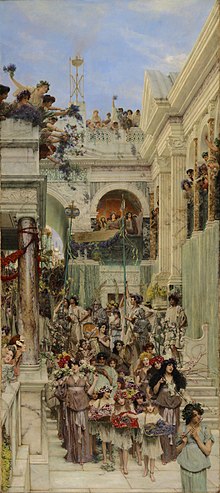
Sir Lawrence Alma-Tadema was a Dutch painter who later settled in the United Kingdom, becoming the last officially recognised denizen in 1873. Born in Dronryp, the Netherlands, and trained at the Royal Academy of Antwerp, Belgium, he settled in London, England in 1870 and spent the rest of his life there.
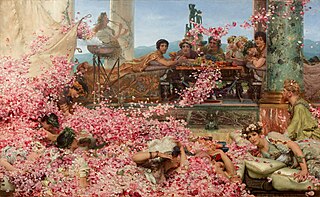
The Roses of Heliogabalus is an oil painting by the Anglo-Dutch artist Sir Lawrence Alma-Tadema, from 1888. It depicts the young Roman emperor Elagabalus hosting a banquet. It is held in a private collection.

John William Waterhouse was an English painter known for working first in the Academic style and for then embracing the Pre-Raphaelite Brotherhood's style and subject matter. His paintings are known for their depictions of women from both ancient Greek mythology and Arthurian legend. A high proportion depict a single young and beautiful woman in a historical costume and setting, though there are some ventures into Orientalist painting and genre painting, still mostly featuring women.
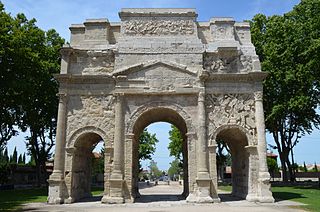
A triumphal arch is a free-standing monumental structure in the shape of an archway with one or more arched passageways, often designed to span a road, and usually standing alone, unconnected to other buildings. In its simplest form, a triumphal arch consists of two massive piers connected by an arch, typically crowned with a flat entablature or attic on which a statue might be mounted or which bears commemorative inscriptions. The main structure is often decorated with carvings, sculpted reliefs, and dedications. More elaborate triumphal arches may have multiple archways, or in a tetrapylon, passages leading in four directions.

The Arch of Constantine is a triumphal arch in Rome dedicated to the emperor Constantine the Great. The arch was commissioned by the Roman Senate to commemorate Constantine's victory over Maxentius at the Battle of the Milvian Bridge in AD 312. Situated between the Colosseum and the Palatine Hill, the arch spans the Via Triumphalis, the route taken by victorious military leaders when they entered the city in a triumphal procession. Dedicated in 315, it is the largest Roman triumphal arch, with overall dimensions of 21 m (69 ft) high, 25.9 m (85 ft) wide and 7.4 m (24 ft) deep. It has three bays, the central one being 11.5 m (38 ft) high and 6.5 m (21 ft) wide and the laterals 7.4 m (24 ft) by 3.4 m (11 ft) each. The arch is constructed of brick-faced concrete covered in marble.
Events from the year 1877 in art.

The Arch of Septimius Severus at the northwestern end of the Roman Forum is a white marble triumphal arch dedicated in 203 AD to commemorate the Parthian victories of Emperor Septimius Severus and his two sons, Caracalla and Geta, in the two campaigns against the Parthians of 194-195 and 197–199. After the death of Septimius Severus, his sons Caracalla and Geta were initially joint Emperors. Caracalla had Geta assassinated in Rome; in the practice now known as damnatio memoriae, Geta's memorials were destroyed and all images or mentions of him were removed from street buildings and monuments. Accordingly, Geta's image and inscriptions referring to him were removed from the arch.

John William Godward was an English painter from the end of the Neo-Classicist era. He was a protégé of Sir Lawrence Alma-Tadema, but his style of painting fell out of favour with the rise of modern art.
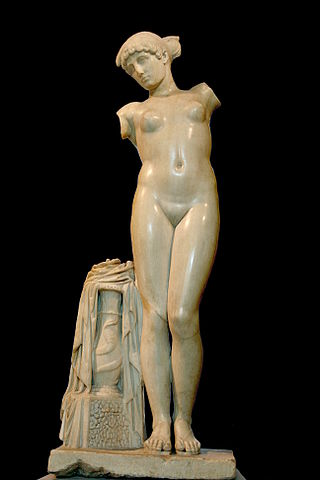
The Esquiline Venus is a smaller-than-life-size Roman nude marble sculpture of a female in sandals and a diadem headdress. There is no definitive scholarly consensus on either its provenience or its subject. It is widely viewed as a 1st-century CE Roman copy of a Hellenistic original from the 1st-century BCE Ptolemaic Kingdom, commissioned by emperor Claudius to decorate the Horti Lamiani.

The Course of Empire is a series of five paintings created by the English-born American painter Thomas Cole between 1833 and 1836, and now in the collection of the New-York Historical Society. The series depicts the growth and fall of an imaginary city, situated on the lower end of a river valley, near its meeting with a bay of the sea. The valley is identifiable in each of the paintings, in part because of a distinct landmark: a large boulder is situated atop a crag overlooking the valley. Some critics believe this is meant to contrast the immutability of the earth with the transience of man.

John Reinhard Weguelin was an English painter and illustrator, active from 1877 to after 1910. He specialized in figurative paintings with lush backgrounds, typically landscapes or garden scenes. Weguelin emulated the neo-classical style of Edward Poynter and Lawrence Alma-Tadema, painting subjects inspired by classical antiquity and mythology. He depicted scenes of everyday life in ancient Greece and Rome, as well as mythological subjects, with an emphasis on pastoral scenes. Weguelin also drew on folklore for inspiration, and painted numerous images of nymphs and mermaids.

Jan Verhas or Jan Frans Verhas was a Belgian painter of the Realist school. He was known for his portraits and genre paintings often depicting children of the Belgian bourgeoisie. Jan Verhas also painted history paintings, coastal landscapes, beach scenes, seascapes and the occasional still life of flowers. He was an important representative of the Realist movement in Belgium.

The Triumphal Arch is a 16th-century monumental woodcut print commissioned by the Holy Roman Emperor Maximilian I. The composite image was printed on 36 large sheets of paper from 195 separate wood blocks. At 295 × 357 centimetres, it is one of the largest prints ever produced and was intended to be pasted to walls in city halls or the palaces of princes. It is a part of a series of three huge prints created for Maximilian, the others being a Triumphal Procession which is led by a Large Triumphal Carriage ; only the Arch was completed in Maximilian's lifetime and distributed as propaganda, as he intended. Together, this series has been described by art historian Hyatt Mayor as "Maximilian's program of paper grandeur". They stand alongside two published biographical allegories in verse, the Theuerdank and Weisskunig, heavily illustrated with woodcuts.

Anna Alma-Tadema was a British artist and suffragette.

The Finding of Moses is a oil-on-canvas painting by the Anglo-Dutch artist Lawrence Alma-Tadema, from 1904. It was one of his last major works before his death in 1912, but quickly fell out of favour; according to rumour, it was sold in the 1950s for its frame. After appreciation of Victorian painting was renewed towards the end of the 20th century, it was described in an auction catalogue in 1995 as "the undisputed masterpiece of [Alma-Tadema's] last decade, as well as a late flowering of the nineteenth-century's love-affair with Egypt". It was sold to a private collector at auction in 2010 for nearly US$36 million.
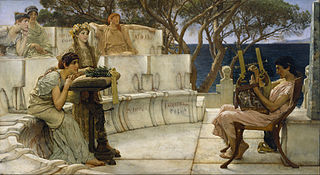
Sappho and Alcaeus is an oil-on-canvas painting by the Dutch-British artist Lawrence Alma-Tadema, from 1881. It is held by the Walters Art Museum, in Baltimore.

Roman Republican art is the artistic production that took place in Roman territory during the period of the Republic, conventionally from 509 BC to 27 BC.

A Reading from Homer is an oil-on-canvas painting executed in 1885 by the English artist Lawrence Alma-Tadema. It depicts an imaginary festival scene from ancient Greece with youth reading poetry to a small audience on a marble balcony overlooking the sea. The painting has been in the collection of the Philadelphia Museum of Art since 1924.

Mischief and Repose is an 1895 oil-on-canvas painting by British artist John William Godward. It has been held by the J. Paul Getty Museum in Los Angeles since 1979. Godward painted a second, smaller painting, with a different composition but the same title, in 1909.

The Art Collection of Henry Gurdon Marquand was a collection of antiques and paintings owned by Henry Gurdon Marquand, the second president of the Metropolitan Museum of Art, until his death in 1902.
